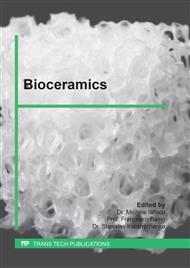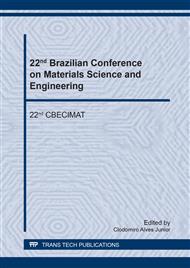p.339
p.345
p.349
p.356
p.362
p.368
p.374
p.380
p.386
Evaluation of the Bactericidal Properties of the Biomimetic Coating of Ha Doped with AgNO3
Abstract:
Commercially pure titanium and its alloys have been widely applied as implant materials with excellent long-term results and present benefits compared to other metal biomaterials because of the good mechanical strength and modulus of elasticity with values close to those of the bone. Titanium implants coated with hydroxyapatite give the metal a bioactive surface, which induces a direct connection between the implant and the bone tissue. As a consequence, the time for osseointegration, and hence the total treatment time, may be reduced. This paper aimed at studying the bactericidal effect of silver nitrate at 10 ppm and 100 ppm, incorporated in the layer on the surface of commercial titanium. The results showed efficiency in both osseointegration and bactericidal effect, confirmed by scanning electron microscopy, X-ray diffraction and corrosion tests. The bacterial culture tests, by means of the halo inhibition tests, indicate that the doping with AgNO3 in concentrations 10 and 100 ppm did not present significant variation.
Info:
Periodical:
Pages:
362-367
Citation:
Online since:
September 2018
Keywords:
Price:
Сopyright:
© 2018 Trans Tech Publications Ltd. All Rights Reserved
Share:
Citation:



